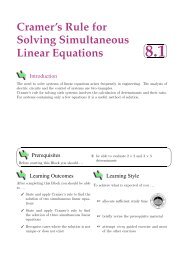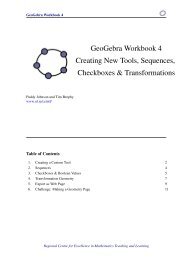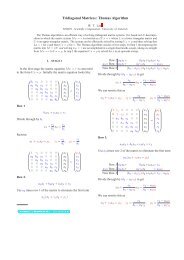Student Notes To Accompany MS4214: STATISTICAL INFERENCE
Student Notes To Accompany MS4214: STATISTICAL INFERENCE
Student Notes To Accompany MS4214: STATISTICAL INFERENCE
Create successful ePaper yourself
Turn your PDF publications into a flip-book with our unique Google optimized e-Paper software.
As this example demonstrates, maximum likelihood estimation does not automati-<br />
cally produce unbiased estimates. If it is thought that this property is (in some sense)<br />
desirable, then some adjustments to the MLEs, usually in the form of scaling, may be<br />
required. We conclude this example with the following tedious (but straightforward)<br />
calculations.<br />
�<br />
1<br />
E<br />
Z2 �<br />
We have already calculated that<br />
However,<br />
�∞<br />
1<br />
= θ<br />
Γ(n)<br />
0<br />
n z n−3 exp −θzdz<br />
= θ2<br />
�∞<br />
u<br />
Γ(n)<br />
n−3 exp −θudu<br />
0<br />
= θ2 Γ(n − 2)<br />
Γ(n)<br />
=<br />
θ 2<br />
(n − 1)(n − 2)<br />
⇒ Var[ ˜ θ] = E[ ˜ θ 2 �<br />
] − E[ ˜ � �<br />
2<br />
2 (n − 1)<br />
θ] = E<br />
Z2 �<br />
− θ 2<br />
=<br />
(n − 1) 2θ2 (n − 1)(n − 2) − θ2 = θ2<br />
n − 2 .<br />
I(θ) = n<br />
θ2 ⇒ E [I(θ)] = n<br />
θ<br />
eff( ˜ θ) =<br />
(E [I(θ)])−1<br />
Var[ ˜ θ]<br />
2 �=<br />
θ2 θ2<br />
= ÷<br />
n n − 2<br />
�<br />
Var[ ˜ �−1 θ] .<br />
= n − 2<br />
n<br />
which although not equal to 1, converges to 1 as n → ∞, and ˜ θ is asymptotically<br />
efficient. �<br />
Example 2.8 (Lifetime of a component). The time to failure T of components has an<br />
exponential distributed with mean µ. Suppose n components are tested for 100 hours<br />
and that m components failed at times t1, . . . , tm, with n − m components surviving<br />
the 100 hour test. The likelihood function can be written<br />
m� 1<br />
L(θ) =<br />
µ<br />
i=1<br />
e−ti/µ<br />
n�<br />
P (Tj > 100) .<br />
j=m+1<br />
� �� � � �� �<br />
components failed components survived<br />
Clearly P (T ≤ t) = 1 − e −t/µ implies P (T > 100) = e −100/µ is the probability of a<br />
component surviving the 100 hour test. Then<br />
L(µ) =<br />
�<br />
m�<br />
1<br />
µ e−ti/µ<br />
�<br />
�e−100/µ �n−m<br />
,<br />
i=1<br />
25






